IRS⁃Enabled Spectrum Sharing:Interference Modeling,Channel Estimation and Robust Passive Beamforming
GUAN Xinrong ,WU Qingqing
(1.College of Communications Engineering,Army Engineering Univer⁃sity of PLA,Nanjing 210007,China;2.State Key Laboratory of Internet of Things for Smart City,University of Macau,Macau 999078,China)
Abstract:Intelligent reflecting surface(IRS),with its unique capability of smartly reconfiguring wireless channels,provides a new solution to improving spectrum efficiency,reducing energy consumption and saving deployment/hardware cost for future wireless networks.In this paper,IRS-enabled spectrum sharing is investigated,from the perspectives of interference modeling,efficient channel estimation and robust passive beamforming design.Specifically,we first characterize the interference in a spectrum sharing system consisting of a single primary user (PU)pair and a single secondary user (SU) pair,and extend it to the large-scale network by leveraging the Poisson point process (PPP).Then,we propose an efficient channel estimation framework based on decoupling the cascaded IRS channels.Moreover,the tradeoff between spectrum efficiency and energy efficiency is derived from the view of channel estimation accuracy.Finally,we discuss the robust passive beamforming design in presence of imperfect channel estimation and nonideal/discrete phase shifts.It is hoped that this paper provides useful guidance for unlocking the full potential of IRS for achieving efficient spectrum sharing for future wireless networks.
Keywords:intelligent reflecting surface;spectrum sharing;channel estimation;passive beamforming
1 Introduction
Over the past few decades,the rapid development of wireless applications and exponentially grown wire‑less devices have led to an ever-increasing demand for a high data rate and seamless coverage.To fulfill these requirements,a variety of wireless technologies have been proposed by academics and engineers,such as ultradense network (UDN),massive multiple-input multiple-output(MIMO),millimeter wave (mmWave) communication,and so on.However,for the future beyond fifth-generation (B5G)wireless network,it becomes insufficient to rely solely on the above technologies,when considering various emerging ser‑vices and applications,such as 3D holographic imaging and presence,5D communications(sight,hearing,touch,smell and taste),and the Internet of Everything(IoE),with more challeng‑ing performance requirements,e.g.,100 Gbit/s to 1 Tbit/s peak data rates,100/m3device density,and 10 times more en‑ergy efficient than 5G[1].For example,seeking more spectrum resources in the mmWave and even terahertz (THz) bands in‑evitably suffers from path loss and blockage.Though densely deployed base stations(BSs)and/or substantially increased an‑tennas at the BSs can help to overcome the above problems,they are faced with practical challenges in terms of energy con‑sumption,hardware cost and signal processing.
Recently,due to the developments in metamaterials/meta‑surfaces,intelligent reflecting surface (IRS)has emerged as an energy-efficient and cost-effective technology to solve the above problems[2-4].Specifically,IRS is a planar surface con‑sisting of a large number of passive reflecting elements,each of which can independently reflect the incident signal with a tunable phase and/or amplitude.By dynamically adjusting the reflecting coefficients to adapt to the wireless propagation en‑vironment,the signal can be enhanced/suppressed in desired/undesired directions.Since IRS requires no power-hungry components,e.g.,radio frequency (RF) chains,it has the po‑tential to achieve near-zero power consumption by exploiting wireless energy harvesting module[5].Moreover,IRS can be in‑tegrated into existing wireless networks without changes at the transceivers,thus providing great flexibility in practical de‑ployment.Owing to the above advantages,IRS has been exten‑sively studied in various wireless systems,such as nonorthogonal multiple access (NOMA)[6-7],simultaneous wireless information and power transfer (SWIPT)[8-9],secrecy communi‑cations[10-12],and so on.
On the other hand,spectrum sharing has been thoroughly in‑vestigated in the literature as an efficient way to solve the spec‑trum scarcity problem,by fully exploiting the opportunities within the limited spectrum resource rather than resorting to higher frequency bands.Provided that the quality of service(QoS)for primary users (PUs)is ensured,secondary users (SUs)can share the same spectrum thus the spectrum efficiency can be significantly improved.However,the SU performance largely decreases in the presence of strong cross-link interference.For instance,considering a spectrum sharing communication sys‑tem consisting of a pair of PU and a pair of SU,the SU rate would be constrained by the strong interference from PT if the primary transmitter is located near the secondary receiver.Al‑ternatively,if the secondary transmitter is located near the pri‑mary receiver,the SU rate would also be constrained since the transmission power of the secondary transmitter should be tuned at an extremely low level for ensuring the reception at the primary receiver.As such,the spectrum sharing efficiency largely depends on the interference distribution.Note that with increased device density,the future wireless network will take the interference challenge to a new level,which will thus limit the application potential of spectrum sharing.
With capability for signal enhancement as well as interfer‑ence suppression,IRS is a promising solution to tackling the above spectrum sharing challenges.Fig.1 shows three typical setups for IRS-enabled spectrum sharing.In particular,in Setup 1,by deploying an IRS nearby the SU cluster,the inter‑ference from the primary BS (PBS) can be efficiently reduced at the SUs,while the desired signal from the secondary BS(SBS) can be enhanced.As such,the transmission power at the SBS can be largely decreased such that the QoS at the PUs can be guaranteed,even if PUs are located near the SBS.In Setup 2,an IRS is deployed nearby the SBS.In this case,the transmission of SBS can be properly tuned so that the signal/interference at the SUs/PUs can be enhanced/reduced.In Setup 3,considering that an IRS is deployed nearby the PU cluster.Then,by mitigating the SBS-PU interference,the SBS can enlarge its transmission power for combating the PBS’s in‑terference at the SUs.
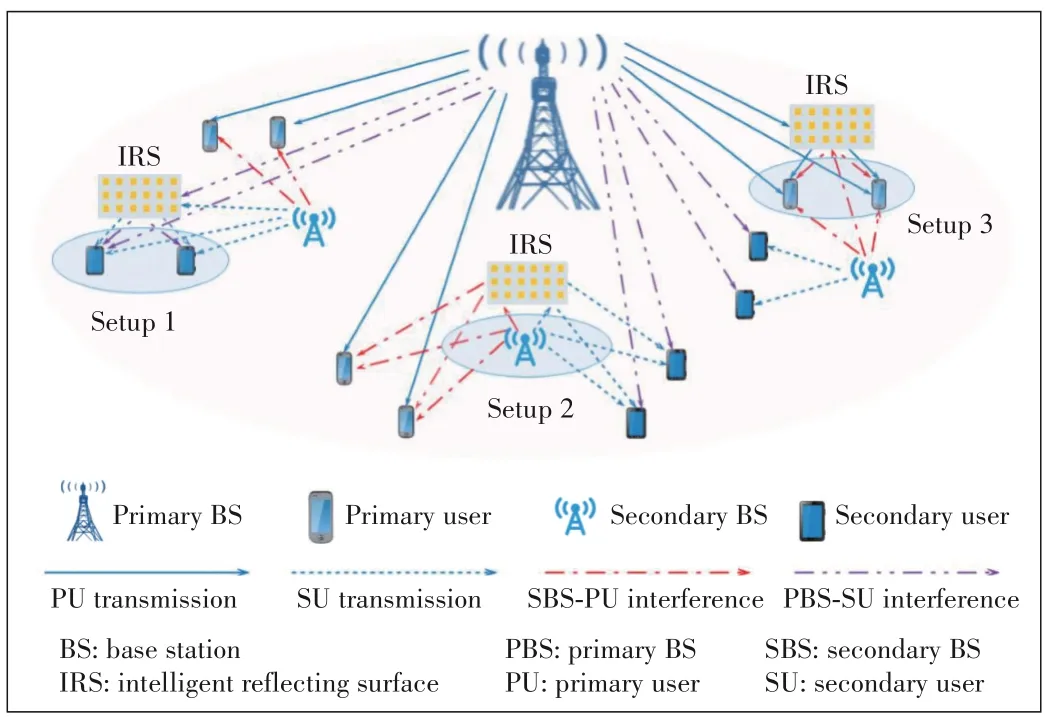
▲Figure 1.IRS-enabled spectrum sharing with different setups
However,most existing works focus on the IRS-aided pointto-point transmission or broadcast system,while its promising channel reconfiguration ability for spectrum sharing,i.e.,inter‑ference channel,has not been well studied.Motivated by this,we investigate the IRS-enabled spectrum sharing,from the per‑spectives of interference modeling,efficient channel estimation and robust passive beamforming design.The main contribu‑tions of this work are summarized as follows.1)An interferencebased performance analysis model is established to evaluate the passive beamforming gain of IRS assisted spectrum sharing system.2)An efficient channel estimation method based on de‑coupling the cascaded reflecting channel is proposed.More‑over,we derive the tradeoff between energy efficiency and spec‑trum efficiency from the perspective of channel estimation ac‑curacy.3) A robust passive beamforming design framework is proposed while considering the imperfect channel estimation and nonideal/discrete reflection coefficients in practice.
The rest of this paper is organized as follows.Section 2 pres‑ents an interference-based performance analysis model.Section 3 discusses the efficient channel estimation and Section 4 inves‑tigates the robust passive beamforming design.Section 5 pro‑vides the numerical results to evaluate the performance of the proposed designs.Finally,we conclude this paper in Section 6.
2 Interference Modeling
It is not easy to evaluate the passive beamforming gain of IRS in spectrum sharing systems due to the complicated links among PUs and SUs.However,considering that the bottleneck of spectrum sharing is the interference,starting from interfer‑ence modeling is expected to provide some useful insights.Thus,in this section,we aim to characterize the performance gain of IRS from the view of interference.In particular,we first consider the IRS-enabled spectrum sharing system con‑sisting of a single PU pair and a single SU pair,and then ex‑tend the analysis to the more general and practical large-scale network setup with massive users.
2.1 Case 1:Single PU Pair and Single SU Pair
Fig.2 shows an IRS-enabled spectrum sharing system,where an SU link consisting of a secondary transmitter (ST)and a secondary receiver (SR) coexists with a PU link consist‑ing of a primary transmitter (PT) and a primary receiver (PR),and an IRS is deployed to assist in the spectrum sharing.As‑sume that all nodes are equipped with a single antenna,while the number of reflecting elements at the IRS is denoted byN.The baseband equivalent channels from the PT(ST) to the PR,SR and IRS are denoted byhpp,hps,hpr∈CN×1,hsp,hssand,respectively,while those from the IRS to the PR and SR are denoted by,respec‑tively.represent the passive beamform‑ing vector of the IRS,wherevn=ejθn,θn∈[0,2π) is the phase shift on the combined incident signal by itsn-th ele‑ment.The composite PT/ST-IRS-PR/SR channel is then mod‑eled as a concatenation of three components,namely,the PT/ST-IRS link,the IRS reflecting with phase shifts,and the IRSPR/SR link.The quasi-static flat-fading model is assumed for all channels.We assume that the channel state information(CSI)of all channels involved is perfectly known at the ST/IRS for the joint power control and passive beamforming design.
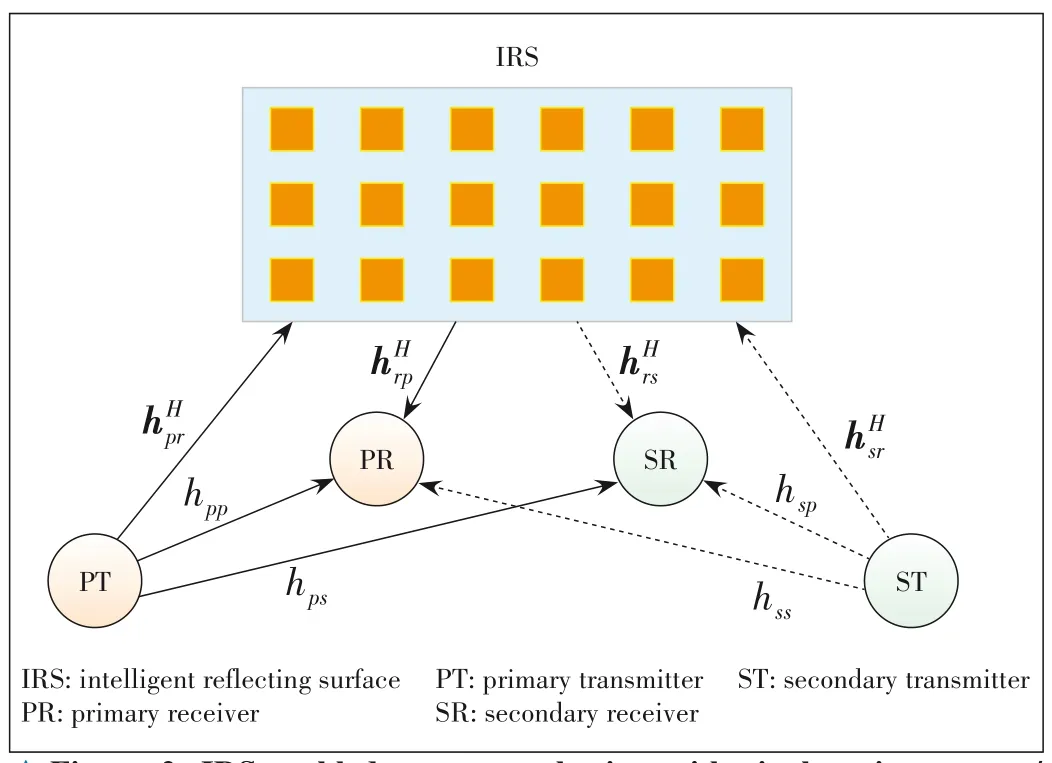
▲Figure 2.IRS-enabled spectrum sharing with single primary-user/secondary-user(PU/SU)pair
Assume that the transmission power at the PT and ST is given byppandps,respectively,while the complex additive white Gaussian noise (AWGN)at the PR and SR is denoted by,respectively.As a result,the received interference power at the PR and SR is respec‑tively given by

Motivated by the above,we focus on the ST-PR interferenceIp,of which the minimum value can be given by

It can be observed that the maximum power gain of the re‑flected channel can be expressed by

which represents the maximum capability of the IRS for inter‑ference mitigating.In particular,if,the interfer‑ence at the PR can be completely reduced,i.e.,Iminp=0,via properly designed passive beamforming.Otherwise,the mini‑mum interference at the PR is then given by

2.2 Case 2:Large-Scale Network with Massive Users
In practical systems,the interference modeling would be much more complex due to massive users.In this subsection,we still focus on the interference at the PR side,which is cru‑cial to the maximum allowed transmission power at STs.Fig.3 shows IRS-enabled spectrum sharing in a large-scale network,where an IRS is deployed nearby the PR to reduce the interfer‑ence from multiple STs.Denote the distances from PT to PR and IRS bydppanddpr,respectively,that from IRS to PR bydrp,and those from thei-th ST to PR and IRS bydsipanddsir,respectively.Assuming that the distribution of STs in the con‑sidered circle area with radiusRfollows a Poisson point pro‑cess (PPP) with densityλs.Denoting the number of STs byK,the probability ofK=kis then expressed by
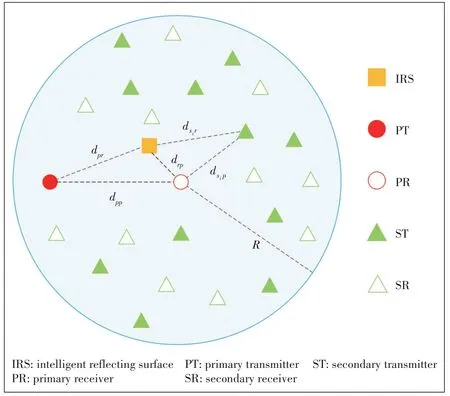
▲Figure 3.IRS-enabled spectrum sharing in large-scale network

Moreover,considering both the path loss and small-scale fading,the channels are given by


It can be observed that the interference powerIplargely de‑pends on a variety of distances,which are random variables themselves.To obtain the statistical characteristics ofIp,we first derive its eigenfunction by

Then,by exploiting the Fourier transformation,the probabil‑ity density function (PDF) ofIpcan be obtained.Note that without IRS,the interference powerIpin Eq.(7)would beIp=.Comparing the PDF ofIpin two cases,some useful insights can be drawn into the performance gain of IRS for spectrum sharing.
3 Efficient Channel Estimation
In IRS-aided wireless systems,channel estimation is funda‑mentally challenging due to the following reasons[13].First,the passive IRS elements can only reflect signals without the capa‑bility of signal transmission/reception,which thus makes the separate estimation of the BS-IRS and IRS-user channels infeasible.Alterna‑tively,a practical approach is to esti‑mate the cascaded BS-IRS-user chan‑nels based on the training signals from the BS/users with properly designed IRS reflection pattern over time[14].Second,since the number of IRS reflecting ele‑ments is generally very large,the train‑ing overhead required for cascaded channel estimation becomes prohibi‑tively high.To reduce the complexity,an element-grouping based channel esti‑mation strategy was proposed in Ref]15].In particular,by grouping the adja‑cent IRS elements into a sub-surface,only the cascaded user-IRS-BS channel associated with each sub-surface needs to be estimated.Moreover,another approach to reduce the pilot overhead is exploiting the IRS channel sparsity,which how‑ever is usually applicable in the IRS-assisted communication system operating at high-frequency bands[16].It should be noted that the above works cannot be straightforwardly ex‑tended to the IRS-aided multiuser system,since they mainly focus on channel estimation for the IRS-aided single-user sys‑tem.As the number of users increases,the required pilot over‑head becomes unaffordable by exploiting the above user-byuser successive channel estimation methods.Especially,for the IRS-enabled spectrum sharing system,in addition to in‑creased transmission links,more interference links are in‑volved,which further makes the channel estimation even more challenging.
In this section,we first propose an efficient channel estima‑tion method for the IRS-enabled spectrum sharing system,which is motivated by the cascaded channel decoupling[17].Then,we discuss the tradeoff between spectrum efficiency and energy efficiency.
3.1 Cascaded Channel Decoupling Based Channel Esti⁃mation
Take the IRS-enabled spectrum sharing system shown in Fig.4 as an example,which consists of a multi-antenna PT,a multi-antenna ST,an IRS and multiple single-antenna PRs and SRs.It can be observed that:1) All cascaded PT-IRS-PR/ST-IRS-SR channels share the common PT-IRS/ST-IRS chan‑nels.If such common channels can be obtained,only IRS-PR/IRS-SR channels need to be estimated for recovering the de‑sired cascaded channels.Meanwhile,the training overhead can be largely reduced since the IRS-PR/IRS-SR channels are of much lower dimension as compared to the cascaded ones.2) Since the locations of PT/ST and IRS are fixed,the above common channels usually vary much more slowly than the IRS-PR/IRS-SR channels,which thus only need to be esti‑mated offline.3)Given the estimated PT-IRS/ST-IRS and IRSSR/IRS-PR channels,the interference channels,i.e.,PT-IRSSR and ST-IRS-PR channels,can be directly obtained via computation,without additional training.Motivated by the above,we propose an efficient channel estimation method based on the cascaded channel decoupling,which is specified as follows and where the estimation of direct channels is omit‑ted for brevity since the focus is the IRS involved channels.
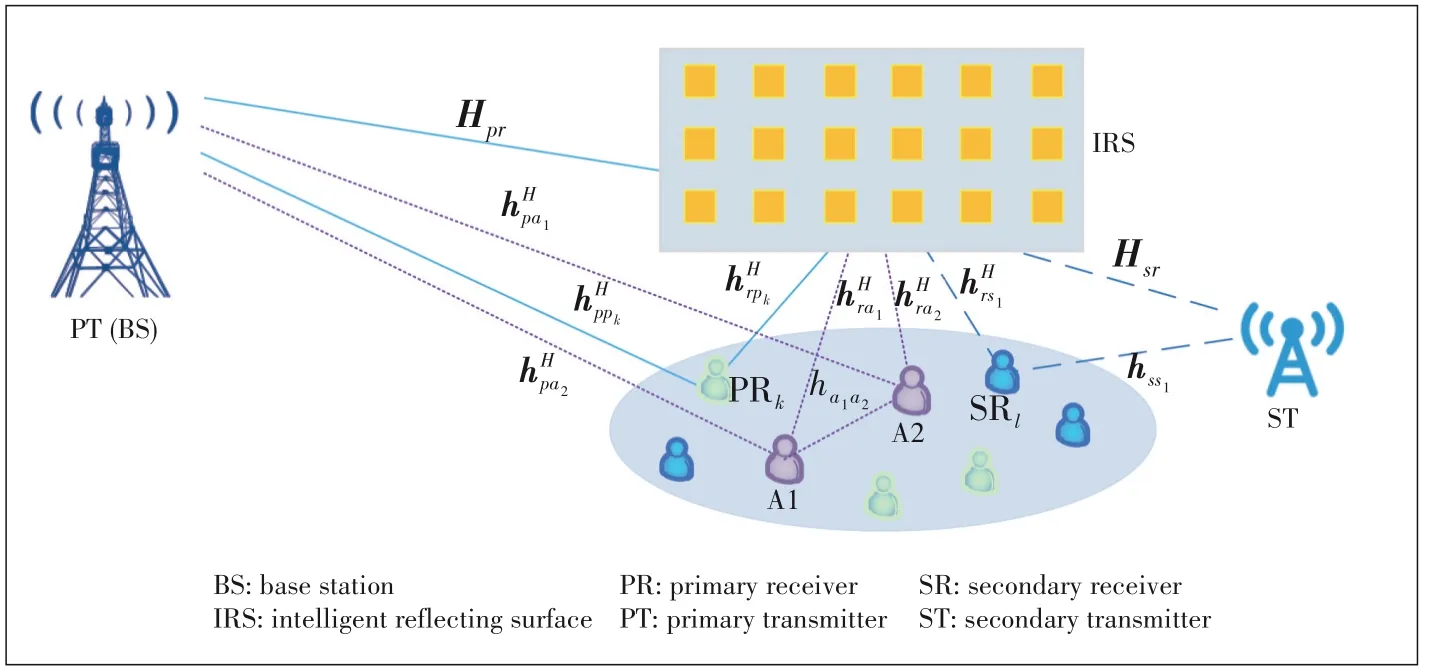
▲Figure 4.Cascaded channel decouple based channel estimation for IRS-enabled spectrum shar⁃ing system
3.1.1 Off-Line Estimation
As shown in Fig.4,two anchor nodes,namely A1 and A2,are deployed nearby the IRS to assist in channel estimation in the considered IRS-enabled spectrum sharing system.First,A1 transmits pilot symbols,while PT,ST and A2 estimate,respectively.Second,A2 feeds back the esti‑matedha1ra2to PT and ST.Third,A2 transmits pilot symbols while PT and ST estimate,respectively.At last,based on the above esti‑matedHpra1,ha1ra2andHpra2,the separate PT-IRS,IRS-A1 and IRS-A2 channels can be obtained at PT[13].Similarly,the STIRS channel can be obtained at ST based on the estimatedHsra1,ha1ra2andHsra2.Note that all of the above channels need to be estimated only once over a long time due to the fixed lo‑cations of the PT/ST,IRS and A1/A2.
3.1.2 On-Line Estimation
First,PRs consecutively transmit pilot symbols,while the PT estimates the IRS-PR channels efficiently by exploiting the offline estimated common PT-IRS channel.Then,the PT computes the desired PT-IRS-PR channels based on the of‑fline estimated PT-IRS channel and the online estimated IRSPR channel.Second,SRs consecutively transmit pilot symbols while the ST estimates the IRS-SR channels efficiently by ex‑ploiting the offline estimated common ST-IRS channel.After that,the ST can compute the desired ST-IRS-SR channels.Third,the PT and ST exchange the estimated IRS-PR and IRS-SR channels,such that they can obtain the CSI of the in‑terference links,i.e.,PT-IRS-SR/ST-IRS-PR without addi‑tional pilot training.
3.2 Tradeoff Between Spectrum Efficiency and Energy Efficiency
Obviously,a training-transmitting tradeoff is involved:too few training results in a coarsely estimated channel at the PT/ST and hence a reduced passive beamforming gain,whereas too much training costs excessive energy and also leaves less time for data transmission.To show the essential insight,we consider the IRS-enabled spectrum sharing system in Fig.2 with single PU/SU pair for brevity.As shown in Fig.5,assuming a channel coherence block ofTc(normalized by symbol duration),the time allocated for channel estimation and data transmission is de‑noted byTeandTd,respectively.Denoting the pilot power at PT/ST and the noise power byp0andσ20,the mean-squared error(MSE) by applying the channel estimation method in Ref]14]is given by.Thus,the channel estimation accuracy improves with largerp0andTe,which thus leads to increased signal-to-interference-plus-noise ratio (SINR) at the PR and SR during the data transmission phase,i.e.,

Note that in spectrum sharing systems,PUs would not adapt their QoS requirement to SUs,while SUs should adjust their transmission strategy even towards a low data rate.If a QoS constraint on PU transmission asγp(p0,T0)≥γth,whereγthis the PU SINR target and corresponds to a fixed PU data rate log2(1+γth),the outage probability of PU transmission is ob‑tained by Pr {γp(p0,T0)<γth}.Based on the above,the aver‑age throughput of the spectrum sharing system during eachTccan be expressed by

One can observe that larger training timeTeon one hand re‑sults in lower outage probability for PU transmission and a higher data rate for SU transmission,but on the other hand renders a lower spectrum efficiency for leaving less time for data transmission.
Next,we consider the energy efficiency of the above channel estimation and data transmission protocol.The transmission power of the PT and ST in the data transmission phase is denoted byppandps,respectively,while the circuit power consumption inTc(including that consumed in PT/PR/ST/SR/IRS)denoted bypc.Thus,the system energy consumption in eachTcis given by

Based on Eqs.(10) and (11),the energy efficiency can be obtained by
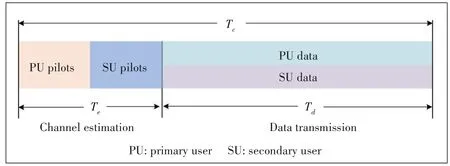
▲Figure 5.A channel estimation and data transmission protocol for the IRS-enabled spectrum sharing system in Fig.2

Next,the tradeoff between spectrum efficiency and energy efficiency can be derived by

which can further be exploited to optimize the parameters set‑tings,such as time/power allocation between the channel esti‑mation phase and data transmission phase.
4 Robust Passive Beamforming Design
Most of the existing passive beamforming designs are based on the assumption of perfect CSI,which is however difficult to obtain in practice due to inevitable estimation errors arising from noise,feedback latency,limited pilot power,and so on[18].Another assumption made in most existing works is that the IRS phase shifts optimized are continuous values,which is also challenging to implement in practice due to hardware limitations and cost control.Thus,implementing discrete and finite reflection phase shifts is more cost-effective.In this sec‑tion,we propose robust passive beamforming designs with im‑perfect CSI and discrete phase shifts,respectively.
4.1 With Imperfect CSI
Considering the IRS-enabled spectrum sharing system shown in Fig.2,we assume imperfect CSI for passive beam‑forming design.Denote=ejω[vH,1],while other notations are the same as those in Sec‑tion 2.We assume that the CSI errors are bounded by some possible values,thus the channels are modeled by

whereξis the radius of the uncertainty region.We aim to maxi‑mize the achievable SU rate via jointing the power control at the ST and the passive beamforming at the IRS,subject to the SINR con‑straint at the PR.Thus,the optimization problem is formulated as
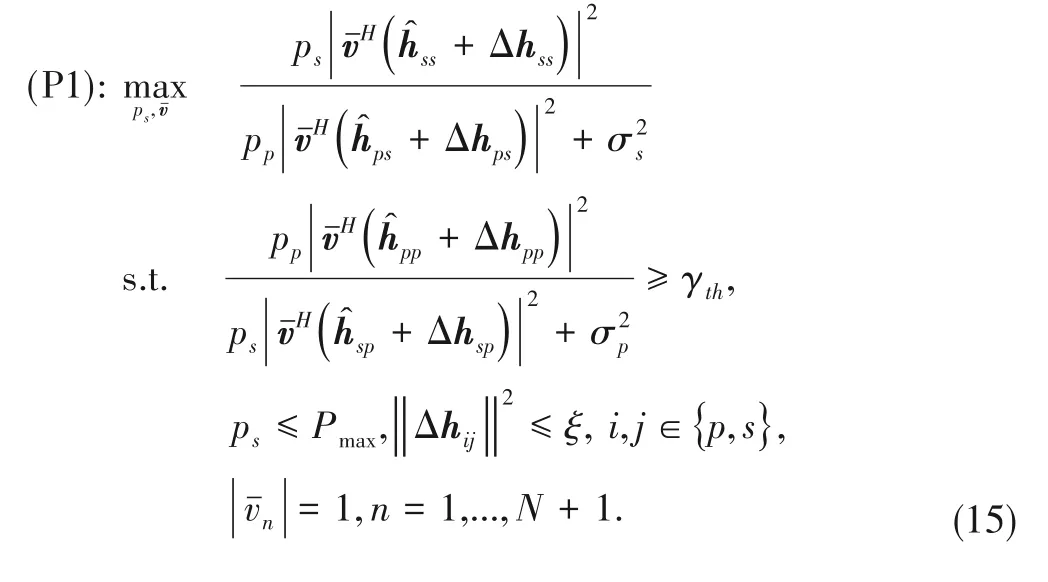
An alternating optimization (AO) based algorithm can be used to solve (P1) sub-optimally,by iteratively optimizing one ofpsandwith the other being fixed at each iteration until the convergence is reached.Specifically,for given,the optimalpscan be easily obtained,whereas optimizingfor givenpsis more challenging due to the channel estimation errors.By in‑troducing variablest,αandβ,(P1)can be rewritten as
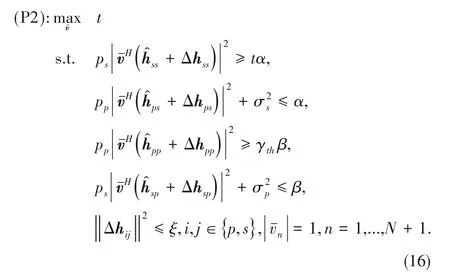
Then,by exploiting S-procedure,the constraints involved with CSI errors can be re-expressed by a variety of linear ma‑trix inequalities.Further,by leveraging the technique of semi‑definite relaxation (SDR),the optimization problem (P2) can be solved.
4.2 With Discrete Phase Shifts
To focus on the discrete passive beamforming design,here we assume perfect CSI for brevity.Denoting the number of tun‑able IRS phase shift byQ,the set of discrete reflection coeffi‑cients for each IRS element can be written asvn∈{0,ejΔθ,...,ej()Q-1Δθ},n=1,...,N.We aim to maximize the achievable SU rate via jointly optimizingpsand,subject to the SINR constraint at the PR.Thus,the optimization problem can be modeled by

Similar to (P2),the above optimization problem can be solved by the AO based algorithm,and we also focus on opti‑mizingfor givenps.Since an IRS usually consists of a large number of reflecting elements,exhaustive search becomes in‑feasible.By denoting,andHij=,i,j∈{p,s},(P3)can be rewritten as

5 Numerical Results
As shown in Fig.6,to study the effectiveness of deploying IRS in a spectrum sharing system,we consider two different setups with strong cross link interference.Specifically,in Setup 1,P1 and P2 work as PT and PR,and S1 and S2 work as SR and ST (thus incurring strong PT-SR interfer‑ence),while in Setup 2,P1 and P2 work as PR and PT,and S1 and S2 work as ST and SR (thus incurring strong ST-PR interference).We assume that the system operates on a car‑rier frequency of 750 MHz with the wavelengthλc=0.4 m and the path loss at the reference distanced0=1 m is given byL0=-30 dB.Suppose that the IRS is equipped with a uni‑form planar array with 6 rows and 10 columns,and the element spacing isλd=3λc/8.The noise power is set as-105 dBm.The channels between PT/ST and IRS/PR/SR are assumed to be Rayleigh fading with the path loss exponents set as 3,whereas the channels between IRS and PR in Setup 1 and SR in Setup 2 are line of sight (LoS) with the path loss exponents set as 2.Besides,the case without IRS but with successive in‑terference cancellation (SIC) at the SR for mitigating the in‑terference from PT,i.e.,(no-IRS,SIC at SR),is also consid‑ered for performance comparison and showing the benefit of using IRS.
Fig.7 shows the achievable SU rate versus the maximum transmit power of the ST in the considered two setups.It can be observed that the case with IRS always achieves a higher SU rate than that of the (no-IRS,SIC at SR) design.Specifi‑cally,in Setup 1,using IRS not only cancels the interference from the PT(P1) to the SR(S1),but also enhances the desired signal from the ST(S2) to the SR(S1);while applying SIC at the SR can only achieve the former.Moreover,the SU rate for the case with IRS eventually saturates.The reason is that both the ST(S2) and the PR(P2) are not in the coverage of IRS and thus the interference from the ST(S2) to the PR(P2) can‑not be reduced,which then constraints the transmitting power at the ST(S2).In Setup 2,the no-IRS design becomes ineffec‑tive,though SIC is applied at the SR(S2).This is because given the severe interference from the ST(S1) to the PR(P1),the former should keep silent to guarantee the reception of the latter.However,by applying the IRS,the above ST-PR in‑terference can be efficiently reduced,thus the SU can access the spectrum and achieve a higher rate with increased trans‑mit power.
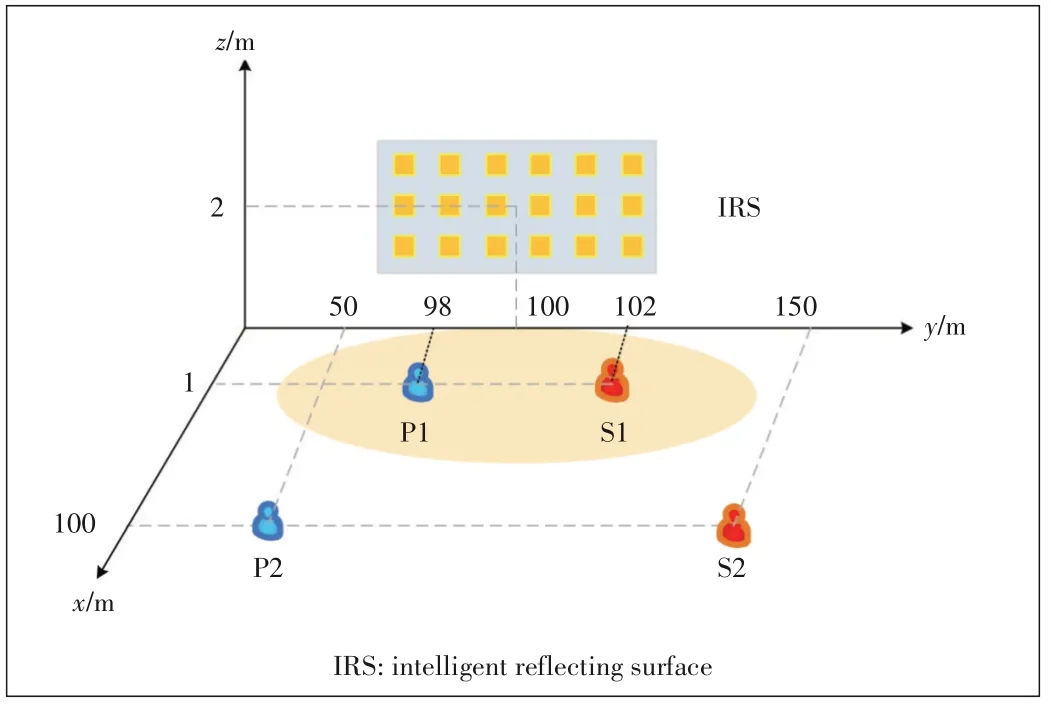
▲Figure 6.Two simulation setups with strong cross link interference
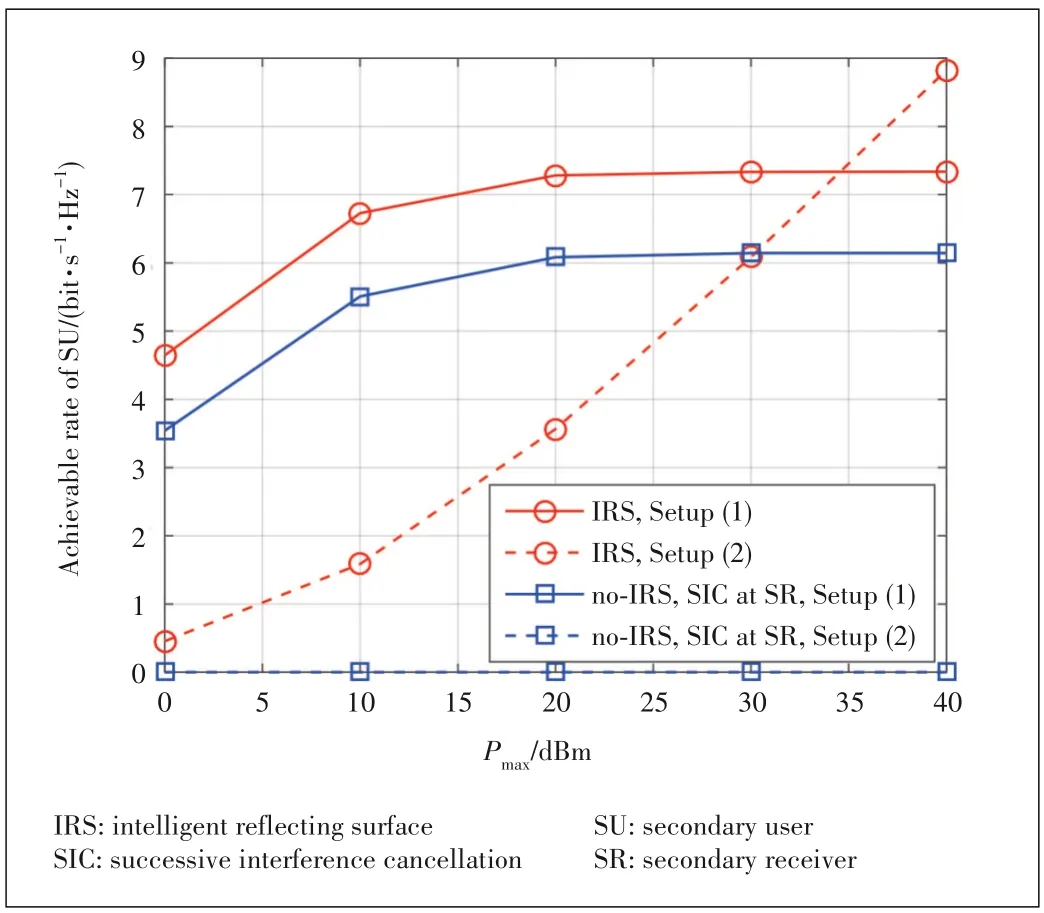
▲Figure 7.Achievable SU rate versus maximum transmitting power at secondary transmitter(ST)
6 Conclusions
IRS has been considered as a promising technology to achieve highly spectral and energy efficient wireless communi‑cation systems.In this paper,we investigate the IRS-enabled spectrum sharing system and highlight several important is‑sues including the modeling of interference,estimation of channels and design of robust passive beamforming.Our simu‑lations show the effectiveness of employing IRS to improve the SU rate and its advantages in dealing with highly challenging interference scenarios in conventional spectrum sharing sys‑tems without the IRS.We hope that this paper would provide a useful guidance for future research into this emerging and promising area.
- ZTE Communications的其它文章
- Editorial:Special Topic on Reconfigurable Intelligent Surface (RIS)
- Recent Progress in Research and Development of Reconfigurable Intelligent Surface
- Some Observations and Thoughts about Reconfigurable Intelligent Surface Application for 5G Evolution and 6G
- New Member of ZTE Communications Editorial Board
- Recent Developments of Transmissive Reconfigurable Intelligent Surfaces:A Review
- Resource Allocation for Two⁃Tier RIS⁃Assisted Heterogeneous NOMA Networks

